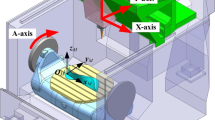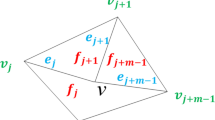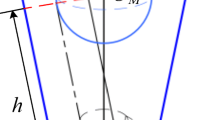Abstract
Increasing the cutter size to enhance its stiffness is of great significance for improving the machining efficiency and precision of deep and narrow channel parts. In this paper, the concept of cutter size critical sphere (CSCS) is presented, which is a specified sphere and tangent to several geometric constraints of tool accessible regions. With this concept, the complex multi-constraints of the workpiece can be transformed into several simple but precise geometric conditions to optimize the size and tool orientation of a conical cutter. The conical cutter generated by CSCS can reach a critical state with multi-constraints simultaneously. Firstly, the mathematical principle of the conical cutter generated by a cylindrical cutter is deduced based on the motion envelope theory. Secondly, the concept of CSCS is proposed based on the deduced mathematical principle and the calculation method of the CSCS with the general situation is provided. Thirdly, the CSCS with special situations is discussed and the calculation method is proposed. Fourthly, the mathematical model and solving algorithm for the max-size CSCS is given. The solving algorithm is designed based on the 3D Medial Axis Transformation (3D MAT) theory. Finally, the proposed method is verified by three simulation experiments and a comparison experiment. The results show that the proposed method can efficiently and accurately calculate the max size and tool orientation of the conical cutter simultaneously. The optimized conical cutter can be tangent to the multi-constraints of the workpiece but do no interfer with them.




































Similar content being viewed by others
References
Liang Y, Zhang D, Ren JX, Li XY (2016) Accessible regions of tool orientations in multi-axis milling of blisks with a ball-end mill. Int J Adv Manuf Technol 85(5–8):1887–1900
Li XY, Ren JX, Kai T, Zhou YK (2019) A tracking-based numerical algorithm for efficiently constructing the feasible space of tool axis of a conical ball-end cutter in five-axis machining. Comput Aided Des 117:102756
Tang TD, Bohez ELJ (2015) A new collision avoidance strategy and its integration with collision detection for five-axis NC machining. Int J Adv Manuf Technol 81(5–8):1247–1258
Lacharnay V, Lavernhe S, Tournier C, Lartigue C (2015) A physically-based model for global collision avoidance in 5-axis point milling. Comput Aided Des 64:1–8
Lin Z, Shen H, Gan W, Fu J (2012) Approximate tool posture collision-free area generation for five-axis CNC finishing process using admissible area interpolation. Int J Adv Manuf Technol 62(9):1191–1203
Ding H, Bi Q, Zhu L, Xiong Y (2010) Tool path generation and simulation of dynamic cutting process for five-axis NC machining. Chin Sci Bull 55(30):3408–3418
Zhang WB, Ren JX (2020) Improving the machining dynamics performance and efficiency for complex channel part manufacturing by planning the tool orientations and feed rate sequence. Int J Adv Manuf Technol 107:3663–3689
Ezair B, Elber G (2018) Automatic generation of globally assured collision free orientations for 5-axis ball-end tool-paths. Comput Aided Des 102(04):171–181
Lu YA, Wang CY, Sun JB, Zheng LJ (2018) Smoothing rotary axes movements for ball-end milling based on the gradient-based differential evolution method. J Manuf Sci Eng 140(12):1–10
Zhang XM, Zhang D, Cao L, Huang T, Leopold J, Ding H (2016) Minimax optimization strategy for process parameters planning: toward interference-free between tool and flexible workpiece in milling process. J Manuf Sci Eng 139(5):051010
Chen L, Xu K, Tang K (2015) Collision-free tool orientation optimization in five-axis machining of bladed disk. J Comput Des Eng 2(4):197–205
Plakhotnik D, Lauwers B (2014) Graph-based optimization of five-axis machine tool movements by varying tool orientation. Int J Adv Manuf Technol 74(1–4):307–318
Mi Z, Yuan CM, Ma X, Shen LY (2016) Tool orientation optimization for 5-axis machining with C-space method. Int J Adv Manuf Technol 88(5–8):1243–1255
Bo P, Bartoň M, Plakhotnik D, Denys P, Helmut P (2016) Towards efficient 5-axis flank CNC machining of free-form surfaces via fitting envelopes of surfaces of revolution. Comput Aided Des 79:1–11
Luo M, Yan D, Wu B, Zhang DH (2016) Barrel cutter design and toolpath planning for high-efficiency machining of freeform surface. Int J Adv Manuf Technol 85(9–12):2495–2503
Meng FJ, Chen ZT, Xu RF, Li X (2014) Optimal barrel cutter selection for the CNC machining of blisk. Comput Aided Des 53(5):36–45
Yu L, Zhong L, Wang YH (2017) Shape optimization of generic rotary tool for five-axis flank milling. Int J Adv Manuf Technol 93(3):1–11
Lu YA, Bi QZ, Zhu LM (2014) Five-axis flank milling of impellers: optimal geometry of a conical tool considering stiffness and geometric constraints. Proc Inst Mech Eng B 228(1):1226–1236
Zheng G, Zhu LM, Bi QZ (2012) Cutter size optimisation and interference-free tool path generation for five-axis flank milling of centrifugal impellers. Int J Prod Res 50(23):6667–6678
Chang ZY, Wen J, Chen ZC, Zhang DH (2017) A reliable and efficient approach to numerically controlled programming optimization for multiple largest tools cutting Blisks patch by patch in the Blisks' four-Axis rough machining. J Manuf Sci Eng 136(9):091013
Li XY, Ren JX, Tang K, Liang YS, Liu CL (2019) Optimization of cutter profile for achieving maximum stiffness in five-axis milling of deep and narrow channel parts. J Manuf Proc 37:541–555
Zhu LM, Ding H, Xiong YL (2012) Simultaneous optimization of tool path and shape for five-axis flank milling[J]. Comput Aided Des 44(12):1229–1234
Zhu LM, Zhang XM, Zheng G, Ding H (2009) Analytical expression of the swept surface of a rotary cutter using the envelope theory of sphere congruence. J Manuf Sci Eng 131(4):041017
Paulo Davim J (2011) Machining of complex sculptured surfaces. Springer, Berlin
Mathews JH, Fink KD (2004) Numerical methods using MATLAB. Pearson
Ba W, Ren N, Cao L (2015) Geometry of 3D MAT and its application to molding surfaces. Graph Models 82(C):1–12
Ba W, Cao L, Liu J (2012) Research on 3D medial axis transform via the saddle point programming method. Comput Aided Des 44(12):1161–1172
Funding
This work was supported by the National Science and Technology Major Project on CNC Machine tool, China (No.2018ZX04019001).
Author information
Authors and Affiliations
Corresponding author
Additional information
Publisher’s note
Springer Nature remains neutral with regard to jurisdictional claims in published maps and institutional affiliations.
Rights and permissions
About this article
Cite this article
Zhang, W., Ren, J. & Liang, Y. Optimization of the cutter size and tool orientation for reaching the critical state with multi-constraints in deep and narrow channel parts machining. Int J Adv Manuf Technol 110, 1969–2001 (2020). https://doi.org/10.1007/s00170-020-05800-1
Received:
Accepted:
Published:
Issue Date:
DOI: https://doi.org/10.1007/s00170-020-05800-1




